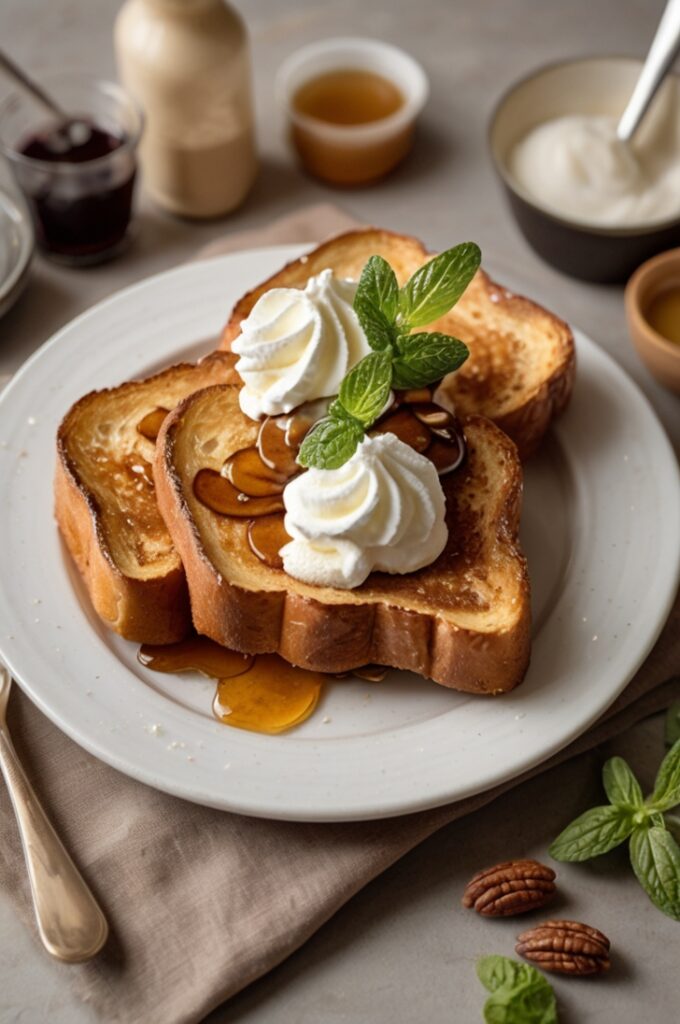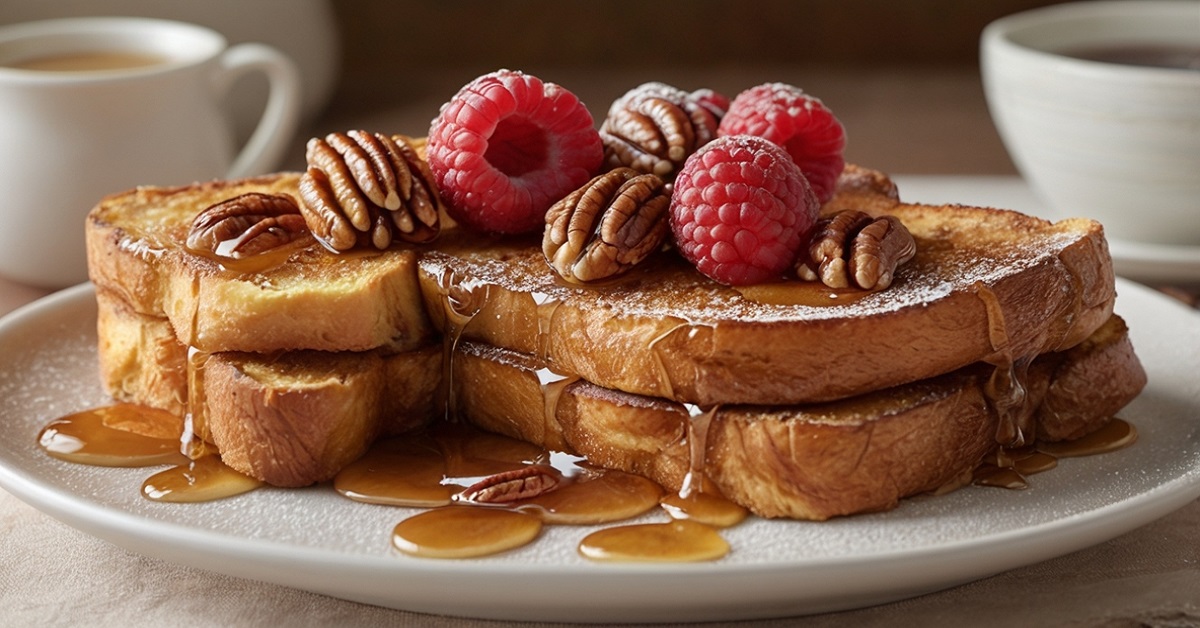Pecan French Toast Recipe Let me tell ya there was a morning in Savannah, mid-July, heat slapping the side of my face at 7:30 AM. I wandered into a backstreet café where the A/C was wheezing and the coffee came in chipped mugs.
A retired pastry chef ran the place. He made one thing pecan French toast. That’s it. No menu, no choices, no apologies. One bite in and I swear, if butter had a soul, it was whispering through those caramelized pecans. It wasn’t breakfast. It was a sermon.
This ain’t your boxed-bread, rushed-weekend nonsense. This is a custard-soaked, pecan-glazed revelation. The kind of dish that makes line cooks pause and ask what the hell did you do to get that crust?
Professionals know: French toast can be a throwaway. Or it can be… this.
We’re talking about a dish that lands between bread pudding and candy, with crisp edges that shatter and a center that sighs when you cut through it. It’s old-school Southern hospitality, backed up by serious technique and a lotta fat. Let’s break this thing down properly.
What Makes This Pecan French Toast Special?

Three things. Custard depth. Nut caramelization. And timing.
Most folks dunk bread for like, 10 seconds. Wrong. This ain’t a swim it’s a soak. You want your bread to drink up that custard like it owes rent. Then there’s the pecan topping part brittle, part praline, part magic. It’s not on the toast, it becomes part of the toast.
Also: this version bakes instead of pan-frying. Less flair, more consistency. And it means you can scale it. Service for 4 or 40, same method, same results. Bakers, chefs, caterers listen up. This one’s for you.
Ingredients & Substitutions
For the Custard:
- 6 large eggs
- 2 cups whole milk
- ¾ cup heavy cream
- ½ cup packed brown sugar
- 1 tbsp vanilla extract
- 1 tsp ground cinnamon
- ¼ tsp freshly grated nutmeg (pre-ground’s okay but don’t @ me)
- Pinch of kosher salt
For the Bread:
- 1 loaf brioche or challah (day-old preferred), sliced ¾-inch thick
- Sub: sturdy sourdough or Texas toast if you’re desperate. No sandwich bread. It dies in the custard.
For the Pecan Topping:
- 1 cup chopped pecans (toasted, always toasted)
- ½ cup unsalted butter
- ⅔ cup light brown sugar
- 2 tbsp maple syrup (not pancake syrup, I will find you)
- ¼ tsp sea salt
Substitutions & Notes:
- Dairy-free? Go with full-fat oat milk + coconut cream.
- Egg allergy? Use silken tofu custard (blitzed smooth, don’t skimp the vanilla).
- Nut allergy? Skip pecans, sub sunflower seeds or toasted oats. Won’t be the same, but it’ll work.
- Bread must be dry-ish. Fresh = soggy center, no structure. Let it sit out overnight or give it a low oven dry.
Step-by-Step Instructions
1. Make the custard
Whisk eggs like you’re angry. Add milk, cream, brown sugar, vanilla, cinnamon, nutmeg, salt. Mix till smooth but don’t froth it up. Air bubbles = weird texture.
Pro tip: Strain the custard. Yup. Even for toast. Removes chalaza (that eggy stringy bit) and makes a silky finish.
2. Soak the bread
Layer slices in a buttered baking dish (9×13 works). Pour the custard slow let gravity do the work. Flip each slice once to make sure both sides get the soak.
Then wait. At least 30 mins. Overnight is better. If you got time, wrap the dish and toss it in the fridge. The deeper the soak, the richer the flavor. It’s science. Proteins + sugar = Maillard bliss.
3. Make the pecan topping
Melt butter in a saucepan. Add brown sugar, maple syrup, and salt. Stir till smooth, bubbly, and glossy (about 3–4 mins on medium). Take off heat. Stir in pecans.
If it seizes? You probably let it boil too long. Reheat gently with a splash of cream.
4. Assemble & bake
Pour pecan mixture over the custard-soaked bread. Don’t spread it. Just let it drizzle and pool.
Bake at 350°F (175°C) for about 40 mins uncovered. Edges should crisp up, center set but soft. If top’s browning too fast, loosely cover with foil at the 25-min mark.
Don’t pull too early. Undercooked French toast is like biting into wet sponge.
5. Let it rest
Five, ten minutes minimum. Molten sugar burns tongues and ruins brunch. Let those sugars set and the custard firm up. It slices better, too.
Optional Variations:
- Add bourbon to the custard (1 tbsp). Smooth, boozy heat.
- Fold in orange zest. Adds brightness that cuts through richness.
- Use crushed pretzels with the pecans. For that salt-sweet crunch combo.
Cooking Techniques & Science
Why bake, not pan-fry? Uniform texture. Better custard control. And more surface area for pecan coverage. Frying gives you browning, sure, but it’s unpredictable in batches.
The bread matrix matters. Brioche is high-fat, high-protein. It holds shape, soaks evenly, and doesn’t go mushy. Challah works too slightly drier, eggier. Avoid lean white breads they dissolve under pressure.
Butter vs. oil? Butter’s flavor wins, but it burns fast. That’s why it goes in the topping, not under the bread. Grease your dish with a neutral oil or a butter/oil combo.
Caramelization science. Sugar and fat create that toffee-like crust on top. The heat transforms brown sugar into a pseudo-praline. But if the sugar’s not fully dissolved in the butter? Gritty texture. Always melt fully before pouring.
Serving & Pairing Suggestions

Serve warm. Slice into slabs like bread pudding.
Dust with powdered sugar if you’re feelin’ nostalgic. Drizzle with warm maple syrup if you’re a maximalist.
Top with whipped cream or crème fraîche. Add bourbon-soaked cherries if you’re showing off. A few flakes of sea salt? Yes, chef.
Pair with bitter coffee or strong black tea. Acid balances fat. Or go luxe and pour a dry bubbly Champagne brunch never judged anyone.
Sides? Keep it simple. Fresh berries, thick-cut bacon, maybe a peppery arugula salad with lemon vinaigrette. You need something crisp to slice through the gooey.
Don’t serve it cold. It goes dense and sad. Reheat gently in a low oven, never microwave. Microwaves kill joy.
FAQs About Pecan French Toast Recipe
1. Can I prep this ahead of time?
Yes fully assemble it the night before and bake fresh in the morning. Just let it sit at room temp for 20 mins before baking to prevent uneven cooking.
2. Why did my toast come out soggy in the middle?
Probably too much custard, too little soak time, or too fresh bread. Dry bread = structure. Don’t rush it.
3. Can I freeze it?
You can freeze leftovers, but texture takes a hit. If you must, wrap tightly and reheat low-and-slow in the oven.
4. Can I use gluten-free bread?
Yes, but choose a dense, high-starch GF loaf. Some brands collapse under custard weight. Test soak one slice first.
5. How do I keep the pecan topping from getting too hard?
Don’t overboil the sugar-butter mix. And don’t bake it too long. Add a splash of cream or corn syrup if you want a chewier finish.
Need a diagram of custard-soak penetration or caramelization gradient? I can whip one up.
Want a version scaled for commercial kitchens or buffet service? Just holler.
Final Thoughts: Why This Recipe Works
This pecan French toast walks the line between brunch and dessert, rich and balanced, nostalgic and elevated. It’s simple at first glance eggs, milk, bread but the devil’s in the soak, the toast, and the sugar science.
What makes it really work? Texture contrast. Custard softness meets pecan crunch. Sticky meets silky. One bite goes from creamy to crisp in milliseconds.
Great for service. Can be made in advance. Holds shape for plating. Tastes like home but plays like fine dining.
It’s brunch. But it’s also a flex.




